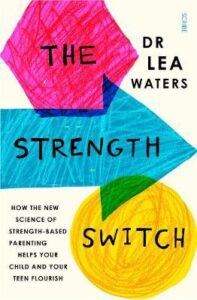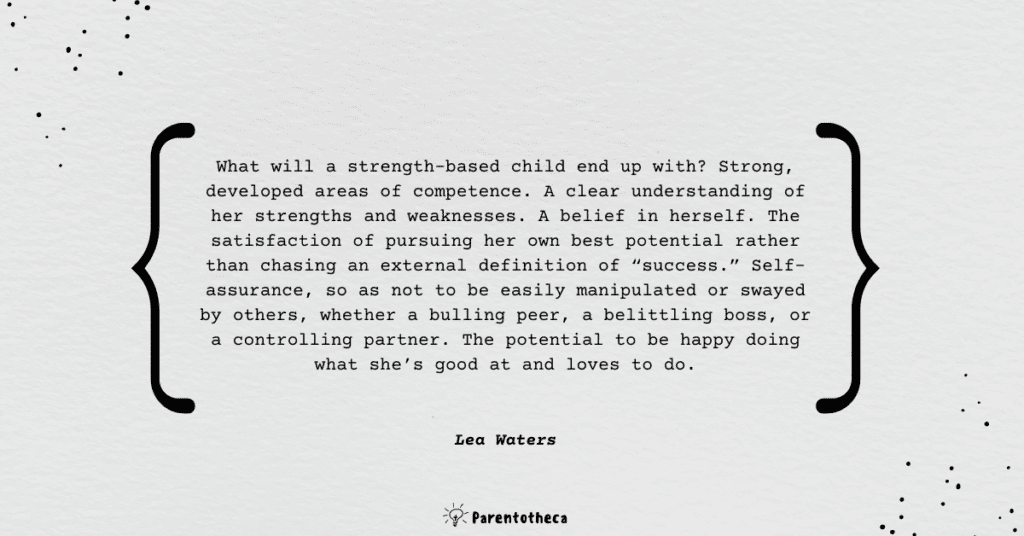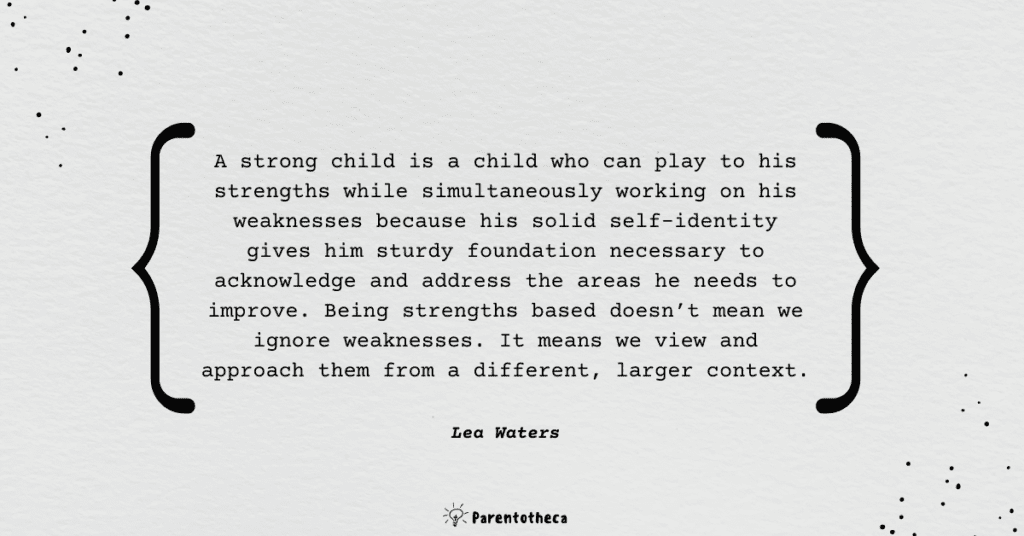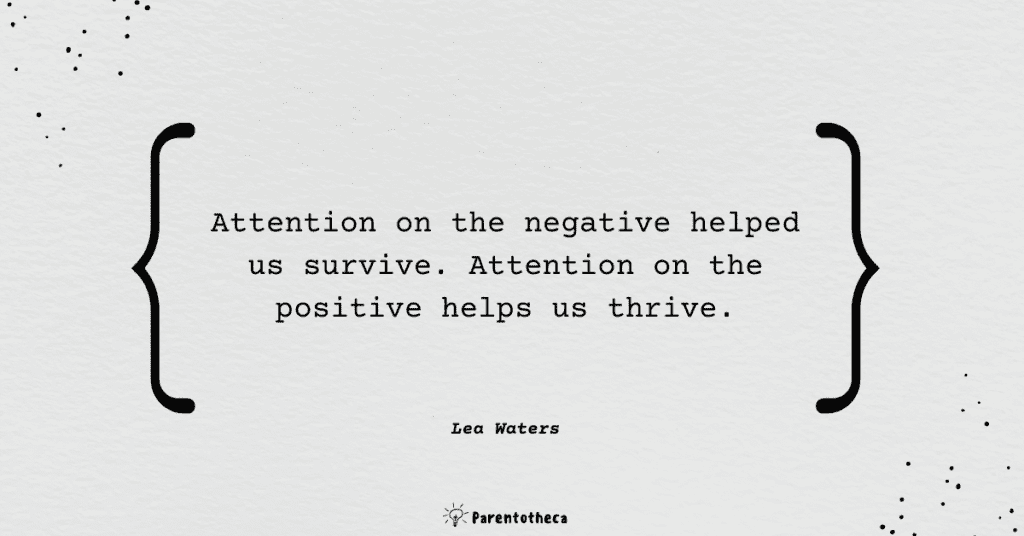 The Strength Switch
The Strength Switch
How the new science of strength-based parenting helps your child and your teen flourish
Dr Lea Waters
Scribe UK; 1st edition (10 Aug. 2017)
About the author
Professor Lea Waters is a psychology researcher at the University of Melbourne, where she has worked for over 20 years. She is the founding Director of the Centre for Positive Psychology, holds the Gerry Higgins Chair in Positive Psychology, and is a registered psychologist and a member of the Australian Psychological Society. She is recognised as a world expert on positive parenting, positive education, and positive organisations, and has affiliate research positions with Cambridge University and the University of Michigan.
About the book:
“Most parents tell me they want to prepare their kids to be optimistic and resilient. But, in my professional opinion, our society has a case of “right intention – wrong direction.” We mistakenly believe that the way to make our kids optimistic and resilient is to weed out all their weaknesses. Strength-based science shows the opposite is true. It tells us to turn the bulk of our attention to expanding their strengths rather than reducing their weaknesses. […]
Focusing on your child’s strengths is the basis of what I call “strength-based parenting” (SBP). My research, coupled with findings in strength-based science, positive psychology, and neuropsychology, my work with parents around the world, and my own experiences as a parent have helped me formulate this positive approach. Testing and analysis have proved its efficacy. This book will help you implement it.”
I came across this book after reading Martin Seligman’s work (The Optimistic Child and Flourish), and I must admit it was on my list for a very long time. When I recently saw it in our local library, I grabbed it immediately and started reading the same evening.
Lea Waters is a positive psychologist who dedicated more than ten years to helping parents around the world bring out the best in their children. In the book, she draws on modern scientific research (all the positive psychology luminaries – Martin Seligman, Carol Dweck, Angela Duckworth and many others!) and her experience to show us how focusing on our children’s strengths rather than always trying to correct their weaknesses, can help build resilience and optimism, and offer protection from today’s pandemic of depression and anxiety.
With many practical suggestions for specific ways to interact with your children, Lea Waters demonstrates how to discover strengths and talents in our kids, how to use positive emotions as a resource, how to build strong brains, and even how to deal with problem behaviours and talk about difficult situations and emotions.
Also, Lea has a great TEDx Talk – check it out, it’s very inspiring!
I personally LOVED the book and can’t wait to share our favourite ideas with you! Let’s jump straight in.
P.S.: in this book, Lea mainly focuses on strength-based parenting, but she also advises educational leaders on implementing these principles in schools. That reminded me of Sir Ken Robinson, who was a strong advocate of the idea that every child is intelligent in his own way (has own strengths) – check out our notes on his fantastic books Creative Schools and You, Your Child, and School, as well as The Future of Smart by Ulcca Joshi Hansen and Free to Learn by Peter Grey.
Key Insights:
Strength-based parenting
“Each of us has many strengths. We all have specific talents (e.g., physical, mental, social, technical, or creative) as well as positive personality strengths (e.g., capacity for courage, kindness, or fairness), some in stronger doses than others. Strength-based parenting puts your kids in touch with their unique constellation of talents (which are performance based) and character (which is personality based). In the process, it changes your kids and it will change you.”
That’s strength-based parenting in a nutshell – focusing on our child’s strengths rather than trying to fix his weaknesses. In a way, it’s the next level of authoritative (aka wise) parenting style.
In the book, Dr Waters shares a great exercise to test your current parenting focus:
“Imagine your child is a lump of clay. Take some time to shape the clay into the form of your child, the same height and shape as your child. Now, step back. What you’ll see is that some parts of the clay are already fully formed and beautifully sculpted. These are your child’s strengths. Other parts are half formed or even not at all formed. These are your child’s weaknesses.
Then I ask parents to think about their child and specifically label some of the strengths and weaknesses they see in this model of their child. “What would you do next.” I ask them, “to help your child grow up so that he’s happy and successful adult?”
If we are tempted to fix the holes, we have a deficit focus (which is not very helpful). If we are up for building on and expanding the clay that’s already there, then that’s the strength focus. You can also take the SBP quiz here.
That also reminds me of Dr Shefali’s wisdom. In The Conscious Parent (check out our notes), she writes:
“Children come to us full of the what is, not what isn’t. When we see our own reality for all it isn’t, we teach our children to operate from lack. When we see our children for all they are yet to become, barely recognizing all they already are, we tech them they are incomplete. For our children to see a look of disappointment in our eyes sows in them seeds of anxiety, self-doubt, hesitation, and inauthenticity. They then begin to believe they should be more beautiful, competent, smart, or talented. In this way, we strip them of their enthusiasm for expressing themselves as they are right now.”
Question for you: what is your parenting focus? How can you shift it more towards the strength focus?
And one more important thing here: strength-based parenting can equip us with the tools to see our children for who they really are – not what we are trying to force them to be. Very powerful.
The Strength Switch – a tool every parent needs
“The Strength Switch acts like a circuit breaker. I literally picture a switch and watch it flick inside my head to turn the spotlight off the negative and turn it on the positive. Its power is in reminding me that in order to be a successful strength-based parent, I need to look at what my kids have done right before I look at what they’ve done wrong. I need to focus on their strengths before their shortcomings.”
That is such a brilliant tool. Flick the strength switch. And look at your child and his behaviour from a different perspective. See good stuff first. Actually, I think this tool perfectly links to the well-researched and scientifically proven Positive Reinforcement Strategy (check out our notes on Jordan Peterson’s brilliant book 12 Rules for Life – we really like how he describes this tool there).
Interestingly, our brains are wired in a way, so it’s easier for us to notice our children’s weaknesses! Yep. There are four cognitive biases to blame:
- Selective attention – our brain filters incoming information to avoid information overload to make sense of the word (like in the gorilla experiment – check it out, it’s fascinating). The key thing is just to be aware of it and remember that we have the power to concentrate our attention at will (I really like how Mihaly Csikszentmihalyi describes this concept in Flow)
- Negativity bias – our brain is wired to see what’s wrong faster and more frequently than what’s right. This bias directs us to see our child’s negative behaviour more often than positive.
- Projection – when we subconsciously project our weaknesses to others or superimpose our strengths or desired strengths to others (by the way, that most likely be your triggers!)
- Binary thinking – leads you to think that weakness and strength are polar opposites (e.g. creative people are not logical).
Although these mental shortcuts are inevitable and may become an obstacle on our way to SBP, we should be aware of them and approach them consciously when interacting with our kids. And it’s worth remembering that those negative defaults are especially likely to kick in when we are preoccupied or tired. That’s when we definitely need the strength switch.
What is a strength?
“It turns out that three elements come together to form a strength. For purposes of strength-based parenting, we need to keep our eye on all three:
1. Performance (being good at something)
2. Energy (feeling good doing it)
3. High use (choosing to do it).”
A strength can be a particular talent (like drawing, music, dancing, or sports) or a positive personality trait (character – e.g. kindness, perseverance, fairness). So to see strengths in your child, ask yourself these three questions: (1) Do I see performance? (2) Do I see energy? (3) Do I see high use?
What is also interesting is that these three elements form a feedback loop for true strengths: “Great performance provides the child with a shot of high energy, so the child naturally chooses to do more. In turn, high use – also known as effort or practice – improves performance levels.”
Dr Waters highlights four types of strengths:
- core strengths (aka our “go-to” strength);
- growth strengths (energize us and offer a potential for good performance, but use is typically medium or low);
- learned behaviour (“things we need to “add in” from the outside”, mostly our motivation to perform them comes from the desire to please others, operate smoothly in the world, or gain external rewards);
- weakness (things we are not good at).
Our main goal as parents (or as educators) is to help our child become aware of his strengths and help him practice them. Of course, different strengths come online at different times, but early childhood and adolescence (when the human brain develops the most) are the best periods of time for the development of strengths:
“If we want to build the brain areas that support our kids’ strengths, we need to create environments and experiences where they frequently use them.”
The more your child practices the strength, the more the neural chain for it is chemically bonded (hello, neuroplasticity – check out our notes on Anders Ericsson’s great book Peak, where he describes how we all can get better at any skill). That’s how mastery is built. And that’s one of the most powerful ways to help your child build healthy self-esteem.
Lea Waters also draws on Angela Duckworth’s formula for achievement (check out our article on that) and presents her very own formula for strength development:
Strength Development = Ability x Effort
So first step is actually to identify and explore your child’s strengths – you can use the following resources for this:
P.S.: Explore your own strengths as well! Check out our notes on Martin Seligman’s great book Flourish, where he talks about how focusing on strengths can improve your wellbeing, and our notes on Happy Together by Suzie and James Pawelski, where they apply this wisdom to relationships.
The four key strength-based parenting strategies
Once you know what your child’s strengths are, here is how you can help him practice them (aka strength-based parenting strategies):
- Mind-set management – encourage growth mindset (and be the role model): “Kids learn growth mind-set from you, and from the moment they try and fail at something – which they’ll do many times – they’re taking away messages from you about 1) how to view and respond to failure and 2) whether strengths can be developed.”
- Role modelling – children are always observing how we use our strengths. If you don’t have the same strengths as your child – find him role models (take him to a museum, concert, art gallery, football match, etc.).
- Scaffolding – ensuring kids have all the resources to develop a strength (e.g. access to classes/lessons).
- Proximal development practices – helping a child build a strength step by step (purposeful practice following the Goldilocks rule. As James Clear puts it in Atomic Habits: “The Goldilocks Rule states that humans experience peak motivation when working on tasks that are right on the edge of their current abilities. Not too hard. Not too easy. Just right.”)
Dr Waters also writes that each of us will have one dominant SBP style: Strength Communicator (when we use conversations with kids to build on their strengths), Strength Creator (through creating strength-based opportunities for their kids) or Strength Activator (through coaching and directly helping kids practice).
Mindful parents, mindful kids
“Your mindfulness spills over onto your children. In one of my studies, I tested parents for their degree of mindfulness and then tested their children for their degree of mindfulness and then tested their children for their levels of mindfulness and stress. The results were staggeringly clear: the more mindful the parent, the more mindful the child – and the more mindful the child, the less stressed the child. Parent mindfulness sets up a successful coping loop in kids. This is something they can take with them wherever they go.”
Mindfulness is not just a modern buzzword. It has a profound impact on our wellbeing, and it also positively impacts our kids. So practice mindfulness and encourage it in your children.
In the book, Lea shares excellent strategies for this – definitely check out for more.
P.S.: I really liked the question from the book that I use now to help our older son work on his worries:
“What’s the story you’re telling yourself right now? How about we just take a pause? What are you thinking? Is that a helpful thought? Is it an accurate thought?”
P.P.S.: Dan Siegel and Tina Payne Bryson strongly advocate the idea of teaching mindfulness to kids and share practical tools for that in their books. Check out our notes on their great book, The Whole-Brain Child, for more.
Self-control and attention
“Self-control isn’t the same as attention, although the two are interrelated. Attention is our capacity for vigilance, to stay focused on one particular thing. Self-control is our ability to stick to our plans and not be derailed by our impulses. Attention is needed for self-control: You have to be aware of something to control it. But self-control is useful in steering our attention toward one thing and away from another. The two go hand in hand.”
Where attention goes, energy flows.
Our role is to help kids become aware of their impulses, assess their pause and plan mode, and set up productive ways to manage their impulses until they can internalise and perform these processes independently. As Ellen Galinsky highlights in Mind in the Making, focus and control involve many of the brain’s executive functions and are critical skills for success in life.
Lea argues that SBP can help tremendously in building self-control muscles in kids. Check out the book for practical strategies.
Strength-based praise
“Strength-based praise combines the best of both worlds by connecting a child with his strengths (person-praise) and then praising him for how he uses those strengths (process-praise) to be a good person or perform well. It says two things to kids:
1. It acknowledges action: “Here’s what you did.” Acknowledging action helps the child understand what worked so she can repeat those actions in the future to replicate her success. This is the process-praise part.
2. It acknowledges strengths” “Here are the strengths you have that helped you.” Acknowledging ability, talent, skills, and positive personality traits recognizes the inner assets the child brought to bear on the situation. This is the person-praise part of the equation. Better yet, because you’re showing her how her strengths work, not just what they are, you’re showing her that strengths are dynamic and can grow. This means that she won’t develop a fixed mind-set and let her self-worth get so tied up in a strength that she’ll limit herself for fear of failing.”
Praise can be a super powerful performance booster. But you have to praise children wisely so they don’t fall into the fixed mindset trap. Lea Waters reflects on Carol Dweck’s research on praise (check out our article for more) and discusses how we can take it further. She calls it “strength-based praise”.
Here is an example of strength-based praise in action: “You did your best and aced the test. Great job!” vs “You’re a hard worker [strength] who is naturally curious [strength] and you put in the hours needed to prepare for this test [action]. Let’s celebrate your hard work paying off!”
Strength-based discipline
“Strength-based discipline is based on the premise that by nature we are motivated to self-develop. Negative patterns or behaviours signify a block in our drive toward strength-based growth. Strength-based discipline is about working with a child to discover what’s blocking his progress and helping him get back on track.”
That’s the basics of the positive strength-based discipline. Lea writes that the most common discipline strategies are shame-based (negatively impacting the self-esteem of a child and not very effective) and guilt-based (can be sometimes effective, but not teaching a child alternative behaviour). I guess now positive parenting is also picking up, which is pretty effective. But Lea suggests taking it to a different level and reframing the message from the point of view of a child’s strengths:
“Whereas guilt-based discipline tells children what not to do, strength-based discipline goes a step further, letting our kids know what they can do – reminding them of strengths they possess to address the problem. We show them how to reach within to find the resources for change, rebound from setbacks, focus their attention on repairing the problem, and move in a more positive direction.”
And here are a couple of strength-based discipline strategies: talk to your child about dialing up or dialing down a strength; encourage a strength vs fixating on the negative behaviours; substitute or swap in a strength (e.g. instead of approaching weakness first, focus on strengths).
P.S.: don’t forget that behaviour is communication. And it’s always worth looking at the deep reasons underlying the behaviour. Our two favourite books on understanding child’s behaviours are Beyond Behaviours by Mona Delahooke and Help Your Child Deal With Stress – and Thrive by Stewart Shanker. Check out our notes for more.
Action steps for you:
- Explore your child’s strengths (and yours as well) by completing an assessment and deliberately noticing what your child is good at. You can use the VIA Youth survey, the Gallup Strengths Explorer, or the Gallop StrengthsQuest. Think about the strategies you can use to support your child’s strengths development.
- Practice the Strength Switch exercise – start noticing your negative defaults and start changing your perspective on your child’s character and behaviour.
- Practice the Mindful Strength exercise: e.g. swap “How was school today?” to “Which strengths did you use today?” You can also discuss with your child the strengths of other people.
Quotes from the book:









